Identification of Perceived Challenges in the Green Energy Transition by Turkish Society through Sentiment Analysis
Abstract
1. Introduction
- Measuring the reactions and acceptance level of Turkish society regarding the transition to green energy by analyzing YouTube comments containing individual remarks that are produced from news articles featured in international, national, and local media videos and individual videos (shorts).
- Developing a tool to measure the evolving perceptions of society over time for each transition to a green energy source. Identifying the reasons behind changing perceptions and developing policy recommendations accordingly.
2. Materials and Methods
2.1. Natural Language Processing
2.2. The Use and Impact of Social Media
2.3. Green Energy and Public Opinion
2.4. Deep Learning and Transformers
3. Methodology
4. Results
4.1. Data Description
4.2. Experimental Results
5. Discussion
- Nuclear energy is the most important energy source on the agenda of Turkish society, followed by hydroelectric energy and solar energy.
- Political will and incentive policies play a significant role in society’s orientation toward energy policies.
- Although there is no clear public opinion on the safety, waste management, and environmental effects of nuclear energy, the need for energy influences the public’s acceptance of nuclear energy.
- Large-scale projects involving nuclear reactors, dams, solar panels, and wind turbines, supported by the government, are effective in promoting the public adoption of these energy types.
- Negative perceptions of nuclear energy include radiation hazards, environmental pollution, waste management, high investment, and operating costs; negative perceptions of hydroelectric energy include the cost of large dam projects, water management, and environmental impact; negative perceptions of solar energy include environmental and land use and technological risks; negative perceptions of wind energy include noise pollution and impacts on birds and wildlife; negative perceptions of geothermal energy include decreasing underground water levels and damage to agricultural areas; and negative perceptions of bioenergy include waste management and its impact on agricultural areas.
- Continuous, high-capacity energy production and efficiency are effective for nuclear energy, especially large dam projects; and high-capacity energy production for hydroelectric energy, the ability to install solar panels both publicly and individually; low operating costs for solar energy; low cost and low environmental impact for wind energy; long-term low operating and maintenance costs for geothermal energy, and the use of local resources for bioenergy.
6. Conclusions
Author Contributions
Funding
Institutional Review Board Statement
Informed Consent Statement
Data Availability Statement
Acknowledgments
Conflicts of Interest
References
- Androniceanu, A.; Sabie, O.M. Overview of Green Energy as a Real Strategic Option for Sustainable Development. Energies 2022, 15, 8573. [Google Scholar] [CrossRef]
- International Energy Agency (IEA). Global EV Outlook; IEA: Paris, France, 2022. [Google Scholar]
- International Renewable Energy Agency. Advantages of Green Energy. Renew. Energy Rep. 2020, 32, 45–58. [Google Scholar]
- International Energy Agency (IEA). Renewable Energy Market Update; IEA: Paris, France, 2020. [Google Scholar]
- European Commission. The European Green Deal; European Commission: Brussels, Belgium, 2019. [Google Scholar]
- United Nations. Sustainable Development Goals: Goal 7—Ensure Access to Affordable, Reliable, Sustainable and Modern Energy for All; United Nations: New York, NY, USA, 2015. [Google Scholar]
- International Renewable Energy Agency (IRENA). Renewable Capacity Statistics; IRENA: Abu Dhabi, United Arab Emirates, 2021. [Google Scholar]
- Republic of Turkey Ministry of Energy and Natural Resources Website. Available online: https://enerji.gov.tr/bilgi-merkezi-enerji-elektrik (accessed on 2 February 2024).
- Sovacool, B.K.; Dworkin, M.H. Global Energy Justice: Problems, Principles, and Practices; Cambridge University Press: Cambridge, UK, 2015. [Google Scholar]
- Whitmarsh, L. Scepticism and Uncertainty About Climate Change: Dimensions, Determinants and Change Over Time. Glob. Environ. Chang. 2011, 21, 690–700. [Google Scholar] [CrossRef]
- Poortinga, W.; Whitmarsh, L.; Suffolk, C. The Introduction of a Single-Use Carrier Bag Charge in Wales: Attitude Change and Behavioural Spillover Effects. J. Environ. Psychol. 2013, 36, 240–247. [Google Scholar] [CrossRef]
- Converse, J.M. Survey Research in the United States: Roots and Emergence 1890–1960; University of California Press: Berkeley, CA, USA, 1987. [Google Scholar]
- Tourangeau, R.; Rips, L.J.; Rasinski, K. The Psychology of Survey Response; Cambridge University Press: Cambridge, UK, 2012. [Google Scholar] [CrossRef]
- Schuman, H.; Presser, S. Questions and Answers in Attitude Surveys: Experiments on Question Form, Wording, and Context; Sage Publications: Thousand Oaks, CA, USA, 1996. [Google Scholar]
- Bruns, A.; Burgess, J. The Use of Twitter Hashtags in the Formation of Ad Hoc Publics. In Proceedings of the 6th European Consortium for Political Research (ECPR) General Conference, Reykjavik, Iceland, 24–27 August 2011. [Google Scholar]
- Zagheni, E.; Weber, I.; Gummadi, K. Leveraging Facebook’s Advertising Platform to Monitor Stocks. In Proceedings of the Eighth International Conference on Weblogs and Social Media, Ann Arbor, MI, USA, 1–4 June 2014. [Google Scholar]
- Jungherr, A.; Jürgens, P.; Schoen, H. Why the Pirate Party Won the German Election of 2009 or The Trouble with Predictions: A Response to Tumasjan, A., Sprenger, T.O., Sander, P.G., & Welpe, I.M. “Predicting Elections with Twitter: What 140 Characters Reveal About Political Sentiment”. Soc. Sci. Comput. Rev. 2012, 29, 229–234. [Google Scholar] [CrossRef]
- Vosoughi, S.; Roy, D.; Aral, S. The Spread of True and False News Online. Science 2018, 359, 1146–1151. [Google Scholar] [CrossRef]
- Tufekci, Z. Big Questions for Social Media Big Data: Representativeness, Validity and Other Methodological Pitfalls. arXiv 2014, arXiv:1403.7400. [Google Scholar] [CrossRef]
- Liu, B. Sentiment Analysis and Opinion Mining; Morgan & Claypool: San Rafael, CA, USA, 2012. [Google Scholar]
- Parlak Sert, H.; Baskale, H. Students’ Increased Time Spent on Social Media, and Their Level of Coronavirus Anxiety During the Pandemic Predict Increased Social Media Addiction. Health Inf. Libr. J. 2023, 40, 262–274. [Google Scholar] [CrossRef]
- Garcia, M.N.M. Information Retrieval and Social Media Mining. Information 2020, 1, 578. [Google Scholar] [CrossRef]
- Kim, W.; Choi, B.J.; Hong, E.K.; Kim, S.K.; Lee, D. A Taxonomy of Dirty Data. Data Min. Knowl. Discov. 2003, 7, 81–99. [Google Scholar] [CrossRef]
- Babu, M.S.; Ali, A.A.; Rao, A.S. A Study on Information Retrieval Methods in Text Mining. J. Eng. Res. Technol. 2014, 2, 184–190. [Google Scholar]
- Aftab, F.; Bazai, S.U.; Marjan, S.; Baloch, L.; Aslam, S.; Amphawan, A.; Neo, T.K. A Comprehensive Survey on Sentiment Analysis Techniques. Int. J. Technol. 2023, 14, 1288–1298. [Google Scholar] [CrossRef]
- Kokab, S.T.; Asghar, S.; Naz, S. Transformer-Based Deep Learning Models for the Sentiment Analysis of Social Media Data. Array 2022, 14, 100157. [Google Scholar] [CrossRef]
- Bach, M.P.; Kırstic, Z.; Seljan, S.; Turulja, L. Text Mining for Big Data Analysis in Financial Sector: A Literature Review. Sustainability 2019, 11, 1277. [Google Scholar] [CrossRef]
- Sun, S.; Luo, C.; Chen, J. A Review of Natural Language Processing Techniques for Opinion Mining Systems. Inf. Fusion 2017, 36, 10–25. [Google Scholar] [CrossRef]
- Daniel, W.O.; Julian, R.M.; Jugal, K.K. A Survey of the Usages of Deep Learning for Natural Language Processing. IEEE Trans. Neural Netw. Learn. Syst. 2020, 99, 604–624. [Google Scholar] [CrossRef]
- Khurana, D.; Koli, A.; Khatter, K.; Singh, S. Natural Language Processing: State of the Art, Current Trends and Challenges. Multimed. Tools Appl. 2023, 82, 3713–3744. [Google Scholar] [CrossRef]
- Greff, K.; Srivastava, R.K.; Koutnik, J.; Steunebrink, B.R.; Schmidhuber, J. LSTM: A Search Space Odyssey. IEEE Trans. Neural Netw. Learn. Syst. 2016, 28, 2222–2232. [Google Scholar] [CrossRef]
- Chung, J.; Gulcehre, C.; Cho, K.; Bengio, Y. Empirical Evaluation of Gated Recurrent Neural Networks on Sequence Modeling. arXiv 2014, arXiv:1412.3555. [Google Scholar]
- Mathew, L.; Bindu, V.R. A Review of Natural Language Processing Techniques for Sentiment Analysis Using Pre-Trained Models. In Proceedings of the Fourth International Conference on Computing Methodologies and Communication (ICCMC), Erode, India, 11–13 March 2020. [Google Scholar] [CrossRef]
- Bahdanau, D.; Cho, K.; Bengio, Y. Neural Machine Translation by Jointly Learning to Align and Translate. In Proceedings of the International Conference on Learning Representations, San Diego, CA, USA, 7–9 May 2015. [Google Scholar] [CrossRef]
- Vaswani, A.; Shazeer, N.; Parmar, N.; Uszkoreit, J.; Jones, L.; Gomez, A.N.; Kaiser, L.; Polosukhin, I. Attention is All You Need. In Proceedings of the 31st Conference on Neural Information Processing Systems (NIPS 2017), Long Beach, CA, USA, 4–9 December 2017. [Google Scholar] [CrossRef]
- Devlin, J.; Chang, M.W.; Lee, K.; Toutanova, K. Bert: Pre-Training of Deep Bidirectional Transformers for Language Understanding. In Proceedings of the 2019 Conference of the North American Chapter of the Association for Computational Linguistics: Human Language Technologies, Volume 1 (Long and Short Papers), Minneapolis, MN, USA, 2–7 June 2019. [Google Scholar] [CrossRef]
- Alafwan, B.; Siallagan, M.; Putro, U.S. Comments Analysis on Social Media: A Review. ICST Trans. Scalable Inf. Syst. 2023, 10, 1–24. [Google Scholar] [CrossRef]
- Murphy, J.; Link, M.W.; Childs, J.H.; Tesfaye, C.L.; Dean, E.; Stern, M.; Pasek, J.; Cohen, C.; Callegaro, M.; Harwood, P. Social Media in Public Opinion Research: Executive Summary of the Aapor Task Force on Emerging Technologies in Public Opinion Research. Public Opin. Q. 2014, 78, 788–794. Available online: http://www.jstor.org/stable/24545970 (accessed on 12 March 2024). [CrossRef]
- Adams-Cohen, N.J. Policy Change and Public Opinion: Measuring Shifting Political Sentiment with Social Media Data. Am. Politics Res. 2020, 48, 612–621. [Google Scholar] [CrossRef]
- McGregor, S. Social Media as Public Opinion: How Journalists Use Social Media to Represent Public Opinion. Journalism 2019, 20, 1070–1086. [Google Scholar] [CrossRef]
- Kumar, S.; Darshna, A.; Ranjan, D. A Review of Literature on the Integration of Green Energy and Circular Economy. Heliyon 2023, 9, e21091. [Google Scholar] [CrossRef] [PubMed]
- Wu, Z.; He, Q.; Li, J.; Bi, G.; Antwi-Afari, M.F. Public Attitudes and Sentiments Towards New Energy Vehicles in China: A Text Mining Approach. Renew. Sustain. Energy Rev. 2023, 178, 113242. [Google Scholar] [CrossRef]
- Qazi, A.; Hussain, F.; Rahim, N.A.; Hardaker, G.; Alghazzawi, D.; Shaban, K.; Haruna, K. Towards Sustainable Energy: A Systematic Review of Renewable Energy Sources, Technologies, and Public Opinions. IEEE Access 2019, 7, 63837–63851. [Google Scholar] [CrossRef]
- Piselli, C.; Fronzetti Colladon, A.; Segneri, L.; Pisello, A.L. Evaluating and Improving Social Awareness of Energy Communities Through Semantic Network Analysis of Online News. Renew. Sustain. Energy Rev. 2022, 167, 112792. [Google Scholar] [CrossRef]
- Dong, X.; Lian, Y. A Review of Social Media-Based Public Opinion Analyses: Challenges and Recommendations. Technol. Soc. 2021, 67, 101724. [Google Scholar] [CrossRef]
- Yue, L.; Chen, W.; Li, X.; Zuo, W.; Yin, M. A Survey of Sentiment Analysis in Social Media. Knowl. Inf. Syst. 2019, 60, 617–663. [Google Scholar] [CrossRef]
- Rodriguez-Ibanez, M.; Casanez-Ventura, A.; Castejon-Mateos, F.; Cuenca-Jimenez, P.M. A Review on Sentiment Analysis from Social Media Platforms. Expert Syst. Appl. 2023, 223, 119862. [Google Scholar] [CrossRef]
- Moy, P.; Tewksbury, D.; Rinke, E.M. Agenda-Setting, Priming, and Framing. In The International Encyclopedia of Communication Theory and Philosophy, 1st ed.; Wiley: Hoboken, NJ, USA, 2016; pp. 1–13. [Google Scholar]
- Segreto, M.; Principe, L.; Desormeaux, A.; Torre, M.; Tomassetti, L.; Tratzi, P.; Paolini, V.; Petracchini, F. Trends in Social Acceptance of Renewable Energy Across Europe—A Literature Review. Int. J. Environ. Res. Public Health 2020, 17, 9161. [Google Scholar] [CrossRef] [PubMed]
- Stigka, E.K.; Paravantis, J.A.; Mihalakakou, G.K. Social Acceptance of Renewable Energy Sources: A Review of Contingent Valuation Applications. Renew. Sustain. Energy Rev. 2014, 32, 100–106. [Google Scholar] [CrossRef]
- Abdmouleh, Z.; Gastli, A.; Ben-Brahim, L. Survey About Public Perception Regarding Smart Grid, Energy Efficiency & Renewable Energies Applications in Qatar. Renew. Sustain. Energy Rev. 2018, 82, 168–175. [Google Scholar] [CrossRef]
- Fournier, Q.; Caron, G.M.; Aloise, D. A Practical Survey on Faster and Lighter Transformers. ACM Comput. Surv. 2021, 55, 1–40. [Google Scholar] [CrossRef]
- Brasoveanu, A.M.P.; Andonie, R. Visualizing Transformers for NLP: A Brief Survey. In Proceedings of the 24th International Conference on Information Visualisation (IV), Melbourne, VIC, Australia, 7–11 September 2020. [Google Scholar] [CrossRef]
- Kalyan, K.S.; Rajasekharan, A.; Sangeetha, S. AMMUS: A Survey of Transformer-Based Pretrained Models in Natural Language Processing. arXiv 2021, arXiv:2108.05542. [Google Scholar]
- Wang, G.; Smetannikov, I.; Man, T. Survey on Automatic Text Summarization and Transformer Models Applicability. In Proceedings of the CCRIS: International Conference on Control, Robotics and Intelligent System, Xiamen, China, 27–29 October 2020. [Google Scholar] [CrossRef]
- Acheampong, F.A.; Nunoo-Mensah, H.; Chen, W. Transformer Models for Text-Based Emotion Detection: A Review of BERT-Based Approaches. Artif. Intell. Rev. 2021, 54, 5789–5829. [Google Scholar] [CrossRef]
- Gruetzemacher, R.; Paradice, D.B. Deep Transfer Learning & Beyond: Transformer Language Models in Information Systems Research. ACM Comput. Surv. 2022, 54, 1–35. [Google Scholar] [CrossRef]
- Wolf, T.; Debut, L.; Sanh, V.; Chaumond, J.; Delangue, C.; Moi, A.; Cistac, P.; Rault, T.; Louf, R.; Funtowicz, M.; et al. Transformers: State-of-the-Art Natural Language Processing. In Proceedings of the 2020 Conference on Empirical Methods in Natural Language Processing: System Demonstrations, Online, 16–18 November 2020. [Google Scholar] [CrossRef]
- Wang, A.; Singh, A.; Michael, J.; Hill, F.; Levy, O.; Bowman, S. GLUE: A Multi-Task Benchmark and Analysis Platform for Natural Language Understanding. In Proceedings of the 2018 EMNLP Workshop BlackboxNLP: Analyzing and Interpreting Neural Networks for NLP, Brussels, Belgium, 1 November 2018. [Google Scholar] [CrossRef]
- Ibar-Alonso, R.; Quiroga-García, R.; Arenas-Parra, M. Opinion Mining of Green Energy Sentiment: A Russia-Ukraine Conflict Analysis. Mathematics 2022, 10, 2532. [Google Scholar] [CrossRef]
- Kim, S.Y.; Ganesan, K.; Dickens, P.; Panda, S. Public Sentiment toward Solar Energy—Opinion Mining of Twitter Using a Transformer-Based Language Model. Sustainability 2021, 13, 2673. [Google Scholar] [CrossRef]
- Jain, A.; Jain, V. Sentiment Classification of Twitter Data Belonging to Renewable Energy Using Machine Learning. J. Inf. Optim. Sci. 2019, 40, 521–533. [Google Scholar] [CrossRef]
- Li, R.; Crowe, J.; Leifer, D.; Zou, L.; Schoof, J. Beyond Big Data: Social Media Challenges and Opportunities for Understanding Social Perception of Energy. Energy Res. Soc. Sci. 2019, 56, 101217. [Google Scholar] [CrossRef]
- Abdar, M.; Basiri, M.E.; Yin, J.; Habibnezhad, M.; Chi, G.; Nemati, S.; Asadi, S. Energy Choices in Alaska: Mining People’s Perception and Attitudes from Geotagged Tweets. Renew. Sustain. Energy Rev. 2020, 124, 109781. [Google Scholar] [CrossRef] [PubMed]
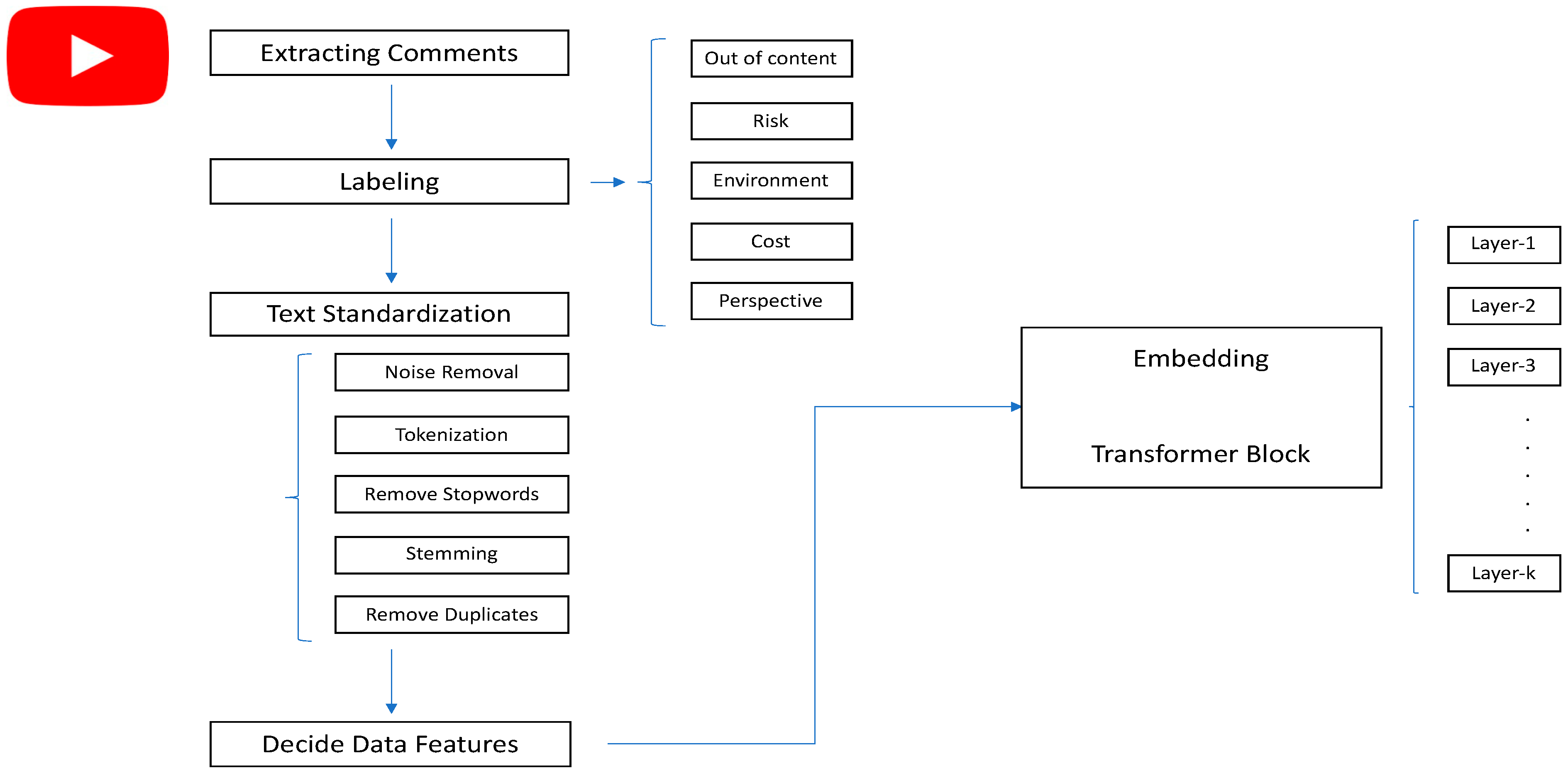
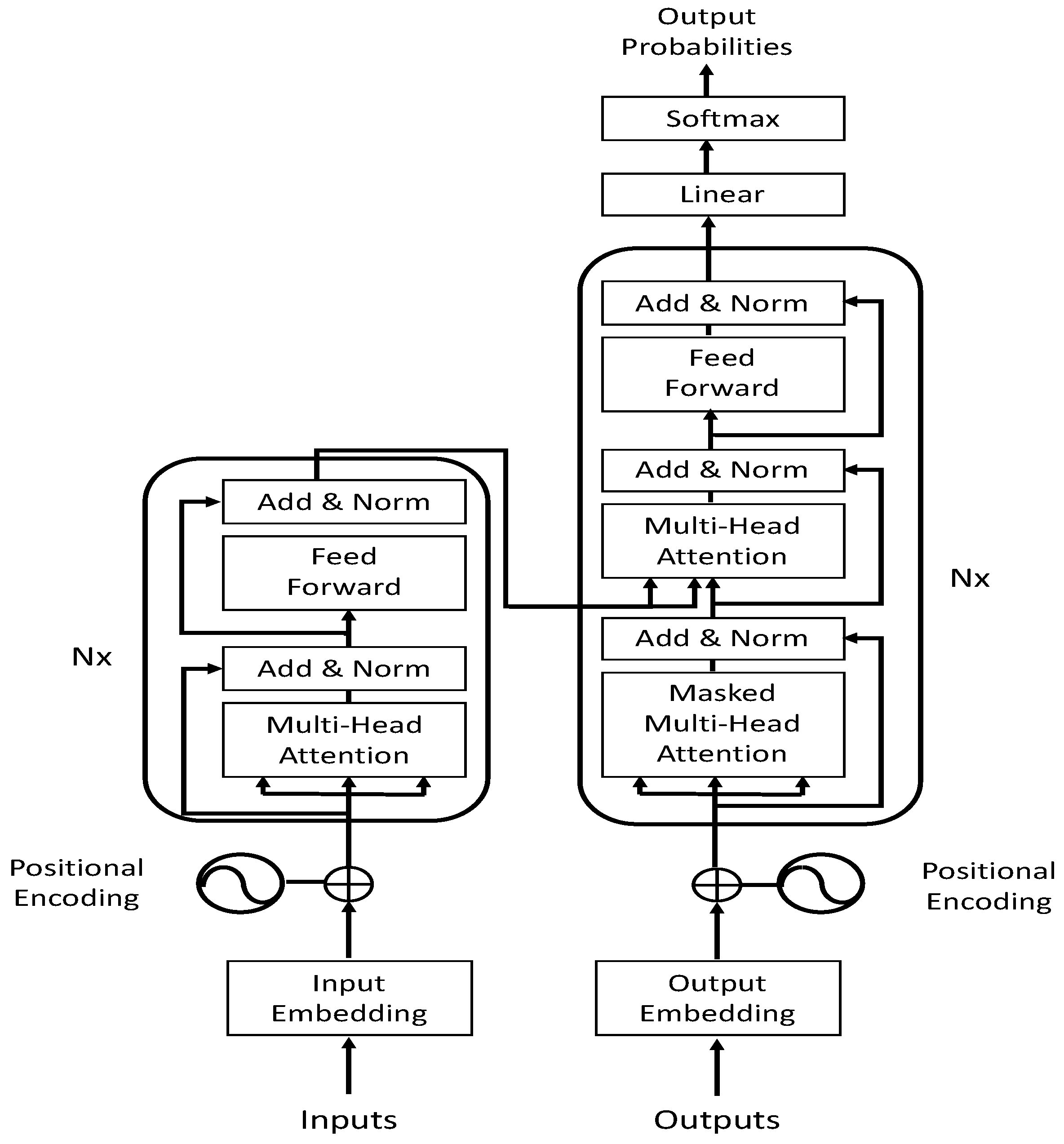



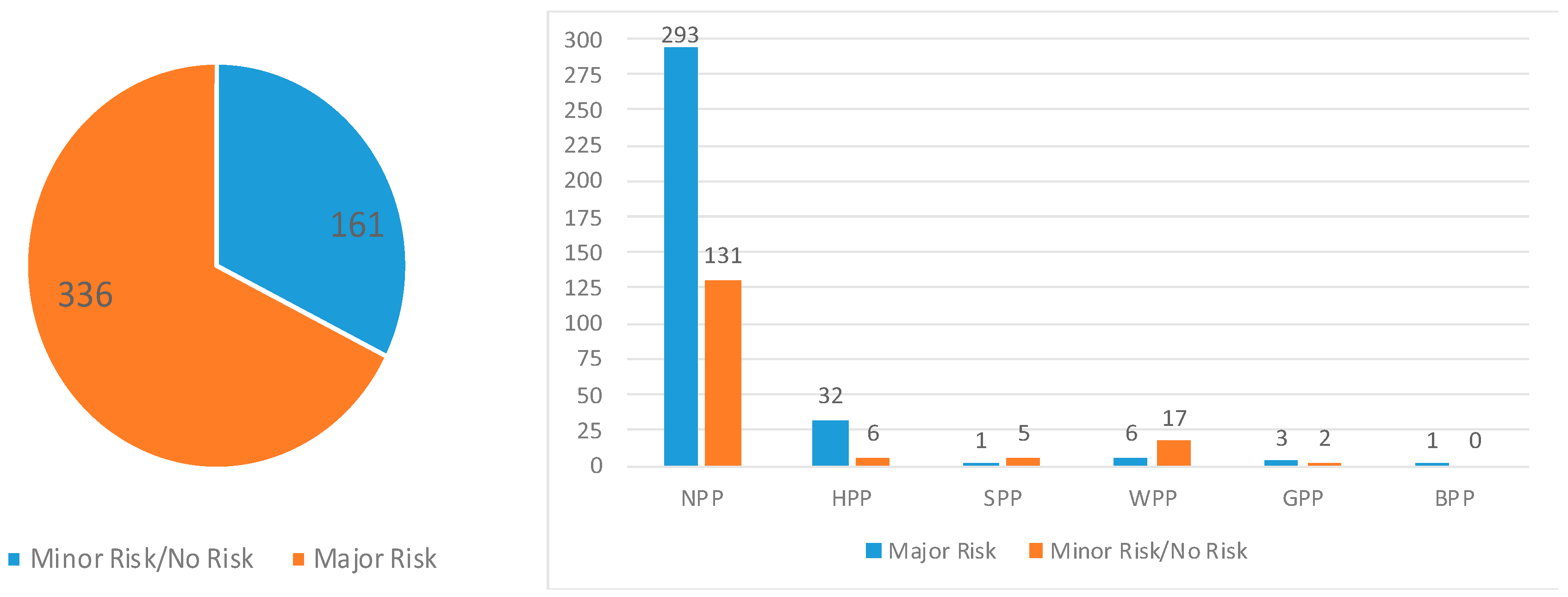
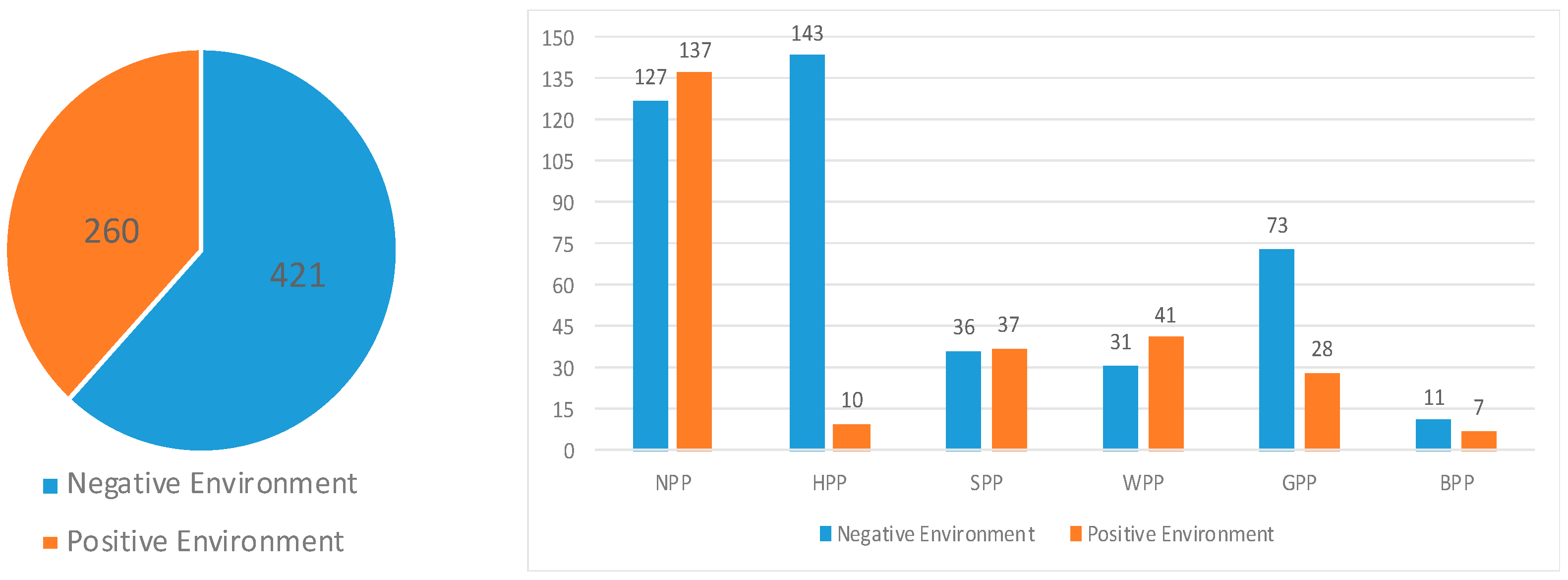
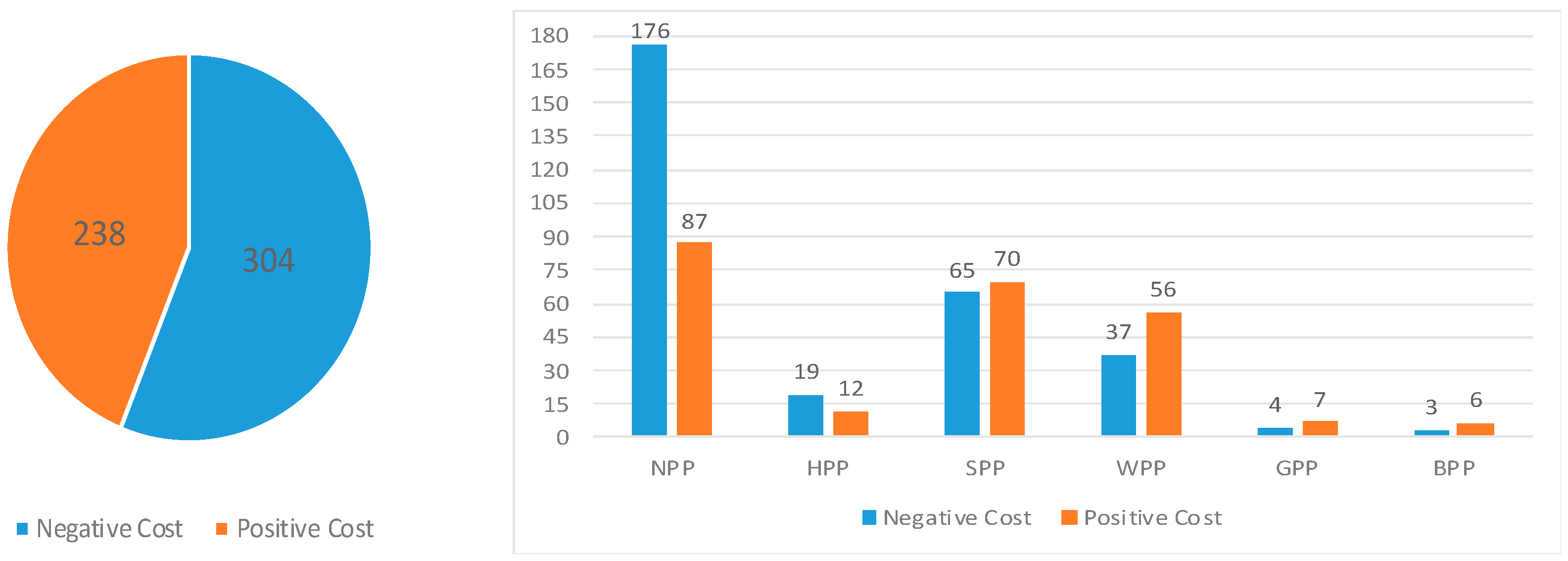
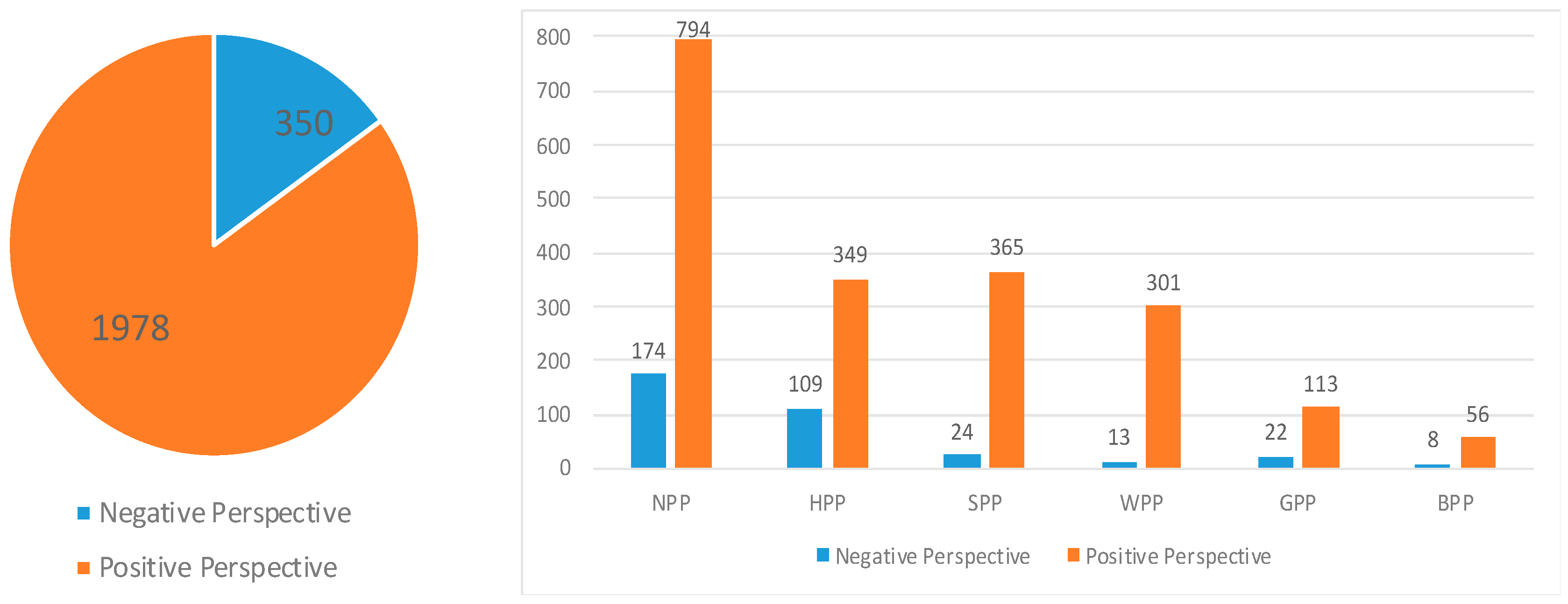
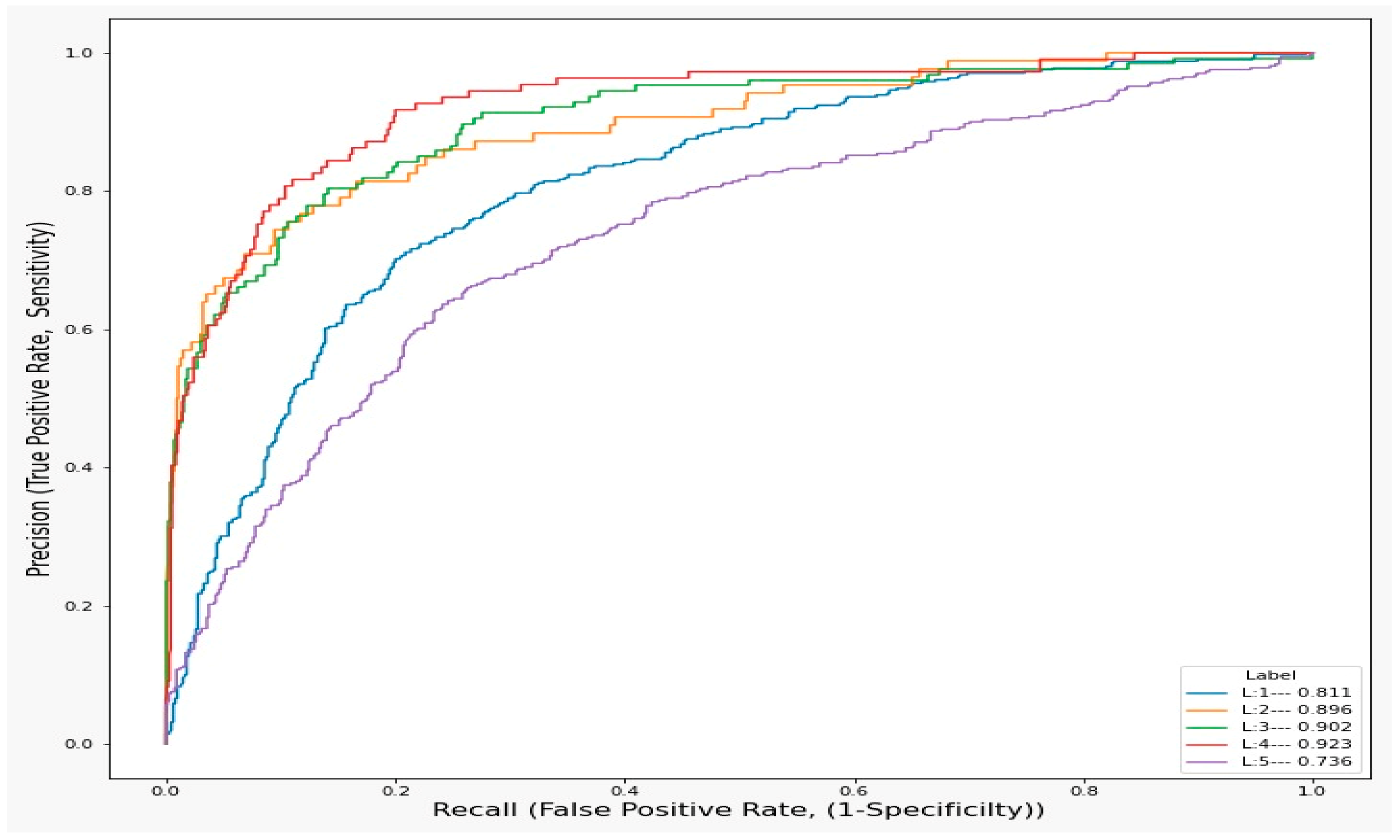

| Roc Auc Score of Categories | |||||||
|---|---|---|---|---|---|---|---|
| Count of Word Diversity | Count of Max Word | Count of Min Word | Out of Content | Risk | Environment | Cost | Perspective |
| 20,000 | 50 | 3 | 0.799 | 0.895 | 0.891 | 0.908 | 0.71 |
| 20,000 | 60 | 3 | 0.811 | 0.896 | 0.902 | 0.923 | 0.736 |
| 20,000 | 70 | 3 | 0.79 | 0.94 | 0.901 | 0.878 | 0.709 |
| 15,000 | 50 | 3 | 0.803 | 0.899 | 0.88 | 0.903 | 0.707 |
| 15,000 | 60 | 3 | 0.81 | 0.894 | 0.881 | 0.865 | 0.714 |
| 15,000 | 70 | 3 | 0.842 | 0.913 | 0.919 | 0.882 | 0.739 |
| 10,000 | 50 | 3 | 0.816 | 0.927 | 0.904 | 0.874 | 0.736 |
| 10,000 | 60 | 3 | 0.807 | 0.899 | 0.883 | 0.874 | 0.73 |
| 10,000 | 70 | 3 | 0.799 | 0.887 | 0.848 | 0.894 | 0.729 |
| Label | Accuracy | Roc_Auc | Precision | Recall | F1_Score |
|---|---|---|---|---|---|
| Out of context | 0.752 | 0.811 | 0.717 | 0.638 | 0.675 |
| Risk | 0.950 | 0.896 | 0.778 | 0.570 | 0.658 |
| Environment | 0.924 | 0.902 | 0.784 | 0.543 | 0.642 |
| Cost | 0.913 | 0.923 | 0.591 | 0.624 | 0.607 |
| Perspective | 0.708 | 0.736 | 0.611 | 0.558 | 0.583 |
Disclaimer/Publisher’s Note: The statements, opinions and data contained in all publications are solely those of the individual author(s) and contributor(s) and not of MDPI and/or the editor(s). MDPI and/or the editor(s) disclaim responsibility for any injury to people or property resulting from any ideas, methods, instructions or products referred to in the content. |
© 2024 by the authors. Licensee MDPI, Basel, Switzerland. This article is an open access article distributed under the terms and conditions of the Creative Commons Attribution (CC BY) license (https://creativecommons.org/licenses/by/4.0/).
Share and Cite
Bilgin, U.; Soner Kara, S. Identification of Perceived Challenges in the Green Energy Transition by Turkish Society through Sentiment Analysis. Sustainability 2024, 16, 3367. https://doi.org/10.3390/su16083367
Bilgin U, Soner Kara S. Identification of Perceived Challenges in the Green Energy Transition by Turkish Society through Sentiment Analysis. Sustainability. 2024; 16(8):3367. https://doi.org/10.3390/su16083367
Chicago/Turabian StyleBilgin, Ugur, and Selin Soner Kara. 2024. "Identification of Perceived Challenges in the Green Energy Transition by Turkish Society through Sentiment Analysis" Sustainability 16, no. 8: 3367. https://doi.org/10.3390/su16083367
APA StyleBilgin, U., & Soner Kara, S. (2024). Identification of Perceived Challenges in the Green Energy Transition by Turkish Society through Sentiment Analysis. Sustainability, 16(8), 3367. https://doi.org/10.3390/su16083367






